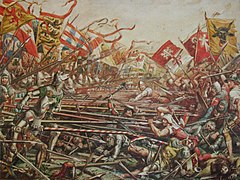Battle of Sempach
[2] In 1385, there were various attacks, without formal declaration of war or central organization, by forces of Zürich, Zug and Lucerne on the Austrian strongholds of Rapperswil, Rothenburg, Cham and Wolhusen.
[3] Lucerne entered further pacts with a number of towns and valleys under Austrian control, including, Meienberg, Reichensee and Willisau.
A local Austrian force defeated the confederate garrison at Meienberg on 28 January, killing over one hundred and forty Swiss soldiers.
Another mockingly pointed to the soldiers setting fire to the ripe fields of grain, and asked them to send a breakfast to the reapers.
Confederate troops of Lucerne, Uri, Schwyz and Unterwalden had marched back from Zürich once it became clear that this was not Leopold's target.
Since the terrain was not deemed suitable for a cavalry attack, Leopold's knights dismounted, and because they did not have time to prepare for the engagement, they were forced to cut off the tips of their poulaines which would have hindered their movement on foot.
The main body of the Confederation army finally completed its deployment from the marching column, formed up, and aggressively attacked the knights from the flank.
[4] Winkelried is usually shown as a legendary figure introduced to explain the Swiss victory against the odds, perhaps as late as a full century after the battle.
One such recorded was Rudolf Hön (today's spelling, Höhn, English, Hoehn), who represented Arth, a municipality in the canton of Schwyz.
For posterity, and recognition of the actual deed, Hön's name can be seen inscribed twice in the list of fallen on the inner wall of Sempach Battle Chapel (situated next to the battleground).
The oldest accounts of the battle are unambiguous in the judgement that the Swiss victory was against all odds and expectations, and is attributed to the grace of God.
The legend goes that a Bohemian knight received seeds of the flower Calla for his protection when he decided to accompany Duke Leopold.
A culture of remembrance formed from the city of Lucerne whose Grand Council ordered in the 1380–1390s to remember the 9 July and that annually for bread to the poor and praise to God and Virgin Mary should be provided with.
[7] In the following two decades, the neighboring towns and districts of Lucerne were still held by the Habsburg dynasty and in them, the Habsburgian fallen were remembered in the churchly mass.
[9] At the peak of the military success of the Eight Cantons in the period of 1470 to 1510, Swiss historiography paid great attention to the Battle of Sempach.
It is depicted in the Swiss illustrated chronicles of the period, and discussed by Reformation era historiographers such as Aegidius Tschudi and Wernher Steiner.
During the World Wars, the Swiss policy of armed neutrality was also ideologically fueled by reference to the military successes of the medieval confederacy.



